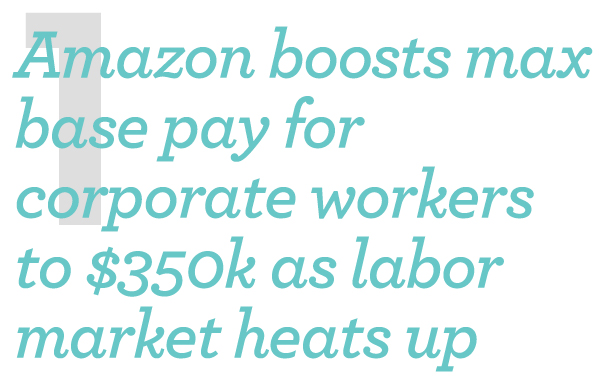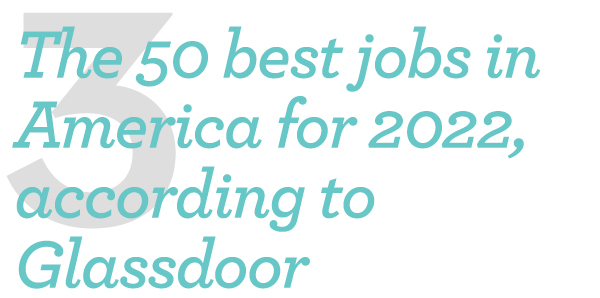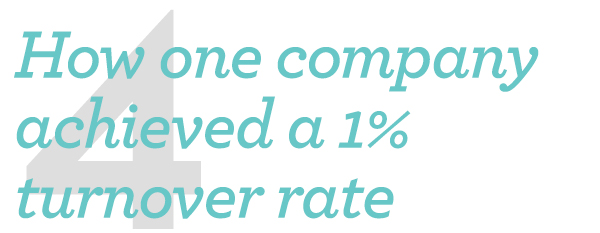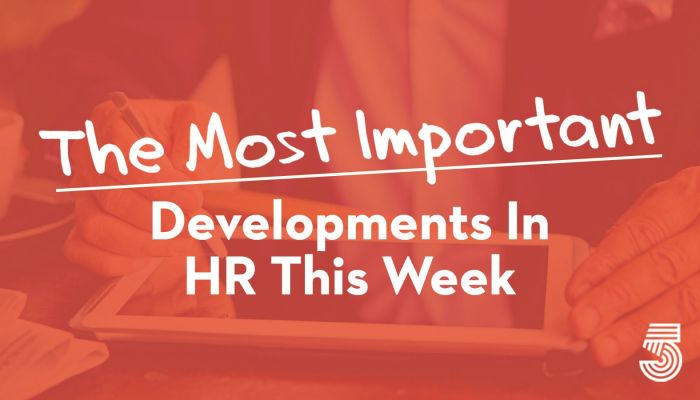The M.I.D., as we call it, is curated by our editorial team from more than 50 news sources. Like a lot of good ideas, this started as something I wanted for myself. If I can’t read everything, I at least want to stay abreast of the most important developments.
This week in HR, Amazon raised its pay cap for execs in response to the hiring wars, retention was in the forefront, Glassdoor released its best jobs in America in 2022 and nobody has heard of the top 4, Lumin Digital CEO shared how he achieved a 1% turnover rate (and it’s not salary), and we were reminded that young workers want purpose.


Amazon is boosting its maximum base salary for corporate workers, citing the competitive labor market as one of several factors behind the change. The company said Monday in an internal memo to employees that it will now cap base pay for all white-collar workers at $350,000, a significant jump from its previous max of $160,000. Base pay is only a portion of employees’ total compensation. This figure does not include restricted stock units, which typically vest in increments over several years, as well as other cash, such as sign-on bonuses. The company’s compensation has historically been weighted heavily to stock. “This past year has seen a particularly competitive labor market, and in doing a thorough analysis of various options, weighing the economics of our business and the need to remain competitive for attracting and retaining top talent, we decided to make meaningfully bigger increases to our compensation levels than we do in a typical year,” according to the memo, which was first reported by GeekWire. CNBC


The churn in the American job market is without precedent. A record number of American workers quit their jobs last year — of the 68.9 million separations in 2021, 47.4 million jobs were left voluntarily. Despite a historic number of job openings, many of the workers who quit never looked for a new gig. Millions of people have left the labor force altogether — to take care of family, retire early, live on savings, or otherwise reassess their lives in COVID. The challenge now is how to get them back. It won’t be easy and it won’t happen overnight. What’s holding them back? Companies are paying higher wages, offering signing bonuses, and adjusting schedules to attract and retain talent. A growing number of companies now pay student debt benefits, hoping to keep good workers from hopping to other employers. “We’re seeing a lot of churn in the jobs market,” Nela Richardson, chief economist at payroll processor ADP told me. “But one thing we are seeing is that hires are higher. They’re not leaving the jobs market, they’re leaving for other jobs in the same industry.” The opportunity for American workers has never been greater, and they’re getting rewarded for quitting. CNN


Two years into the coronavirus pandemic, the workplace has changed dramatically. With millions of Americans working from home and reevaluating what’s most important to them, the jobs considered most desirable have changed — and may even come as a surprise. On Wednesday, job-search platform Glassdoor released its eighth annual list of the 50 Best Jobs in America. Earning potential, job satisfaction, and number of job openings were weighted evenly when determining the ranking. Clinching the No. 1 spot is enterprise architect. Those responsible for ensuring the reliability of their organizations’ IT systems and software, enterprise architects have been instrumental in the shift to remote and hybrid work. In fact, the pandemic propelled the position onto the list in 2021, when it debuted at No. 4. Rounding out the top three is full stack engineer, followed by data scientist. Those in highly technical jobs such as these, and the 21 other tech-related roles on Glassdoor’s list, are often more easily able to work remote or hybrid than their colleagues in other fields. When Glassdoor job reviews with mentions of “hybrid” increased by 626% last year, 80% of those were for jobs in tech. “Candidates are looking for companies that have values that match their ideals,” says David Napeloni, vice president of global client services at Korn Ferry. “A lot of candidates out there are looking for companies that are offering flexibility, not having to be in the office again five days a week or being totally remote and being able to live in another part of the country.” Forbes


Jeff Chambers, CEO of Lumin Digital, knows how important it is to intentionally create the kind of culture you want. Chambers’ goal was to create an intentional culture at Lumin Digital — one employees would love to be a part of. So company leaders got together and came up with some values they wanted the culture to consist of, transparency, inclusion, and flexibility making the top of the list. A big thing Lumin Digital focused on was ensuring employees knew management trusted them. Chambers said this meant managers weren’t constantly checking in with workers. Instead, they expressed confidence in their employees that they could get the job done. Transparency is key to help build this trust. Lumin Digital has weekly roundtable meetings between small groups of employees and company leaders. This creates a relaxed setting for leaders to share important news and for employees to give their input. Employees appreciate the fact they have easy access to company leaders — and this allows them to feel good about sharing opinions. Chambers’ efforts to achieve a transparent, trustworthy culture have paid off. The company boasts an impressive 1% turnover rate. Lumin Digital has also ranked in the 95th percentile for employee engagement. HR Morning


Employees are leaving their jobs at record rates — a phenomenon that has become known as the Great Resignation — with Gen Z and Millennials leading the charge. Representing nearly half of the U.S. workforce, this rising likelihood of turnover presents a critical issue for employers. As the next generation of the workforce reflects on what they want from their employers, organizations too must pause to reflect on how they recruit and retain top talent. In the midst of the COVID-19 pandemic, the Center for Creative Leadership undertook a global research initiative to ask young professionals (defined as 18- to 30-year-olds) why they want to be a leader and what is important to them in their professional careers. More than 15,000 Gen Z and Millennials from 32 countries shared their thoughts, experiences, and reasons for engaging (or choosing not to engage) in leadership positions. Among many critical insights, the importance of being able to identify meaning and purpose in work consistently appeared. Young professionals who found value in their work were more likely to hold a leadership position than those who did not. Emerging leaders who found purpose in their work were also twice as likely to feel empowered in their leadership roles, a key predictor of being effective and engaged at work. For organizations to help young professionals lead with purpose, they need to understand what their emerging leaders care about and intentionally create opportunities to connect that purpose to their work. Training Magazine










